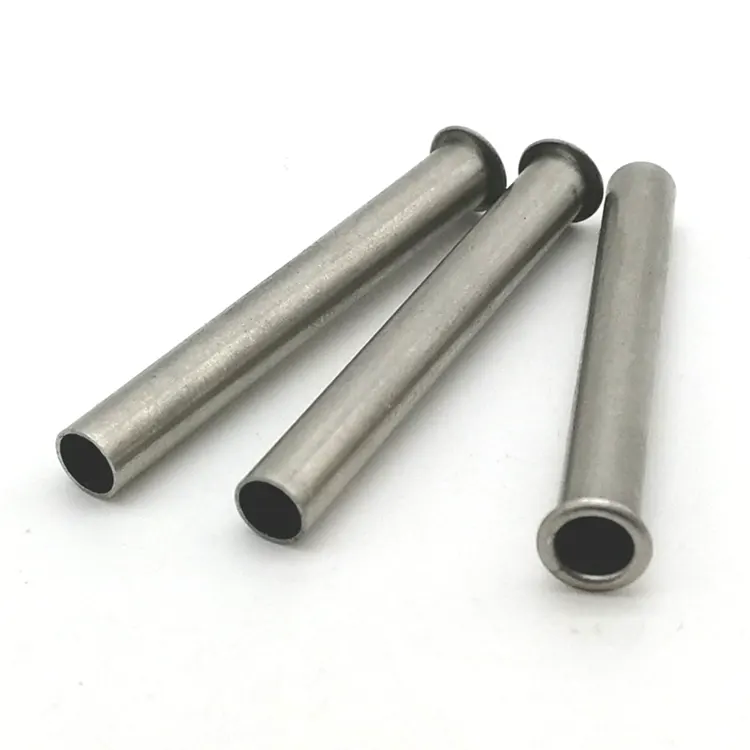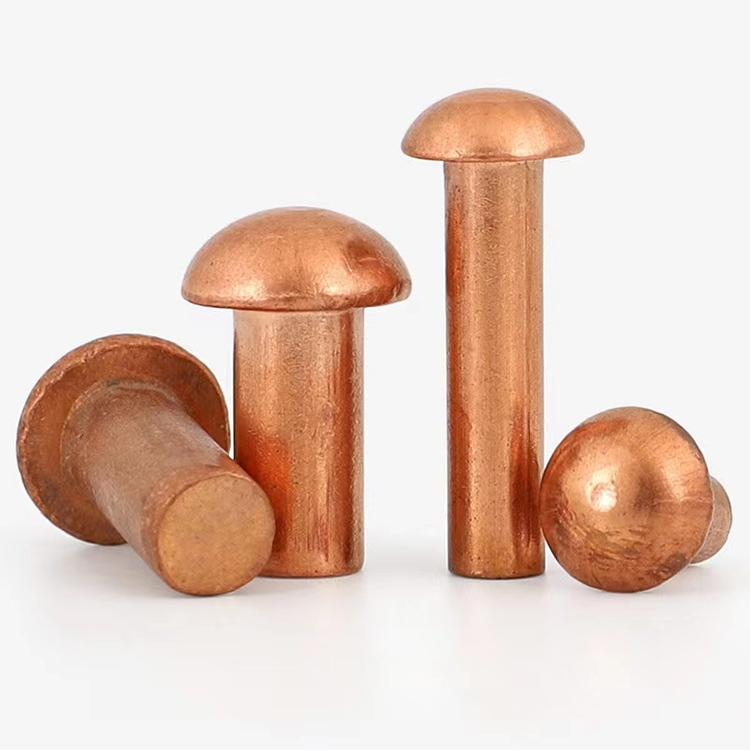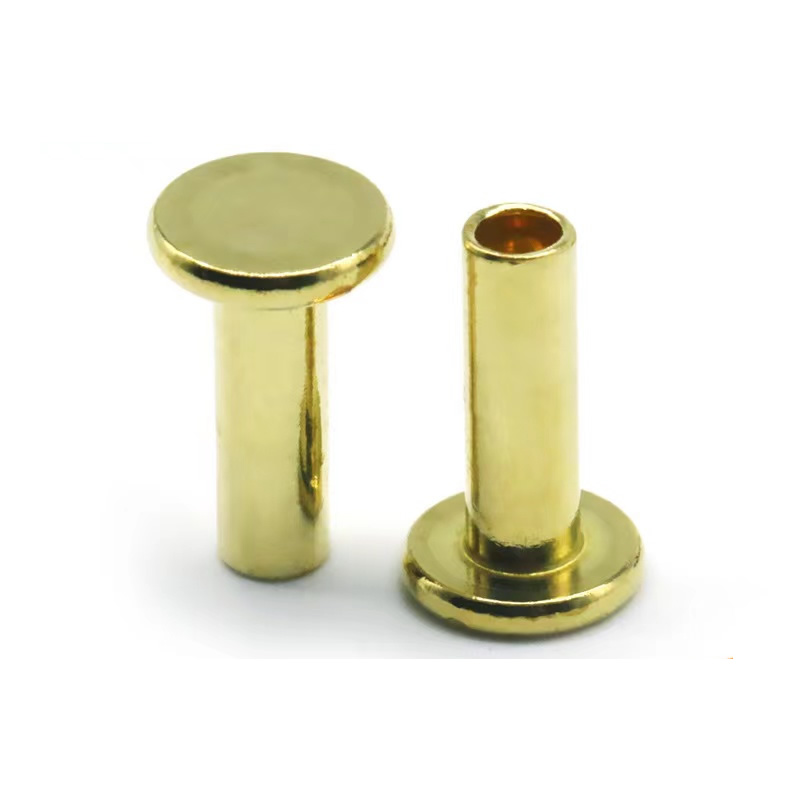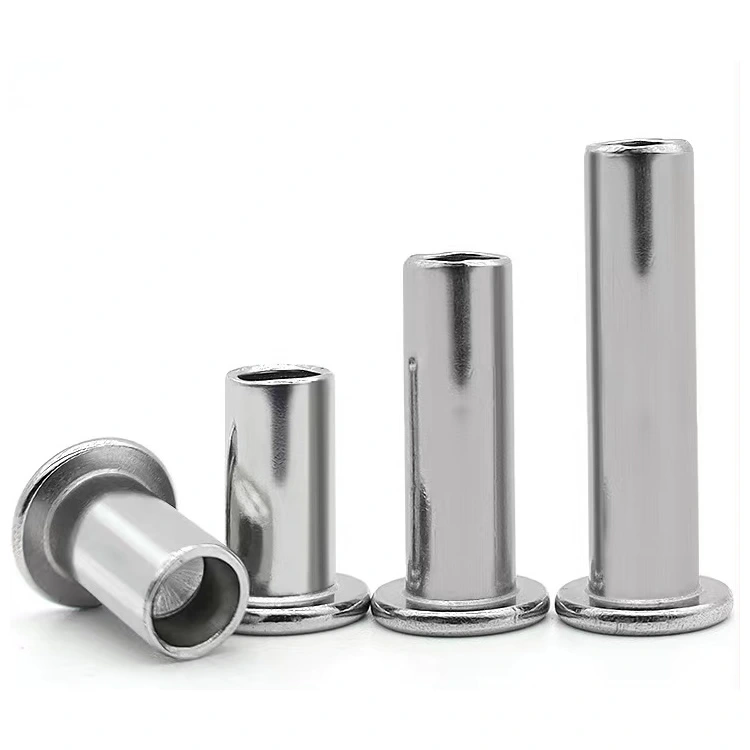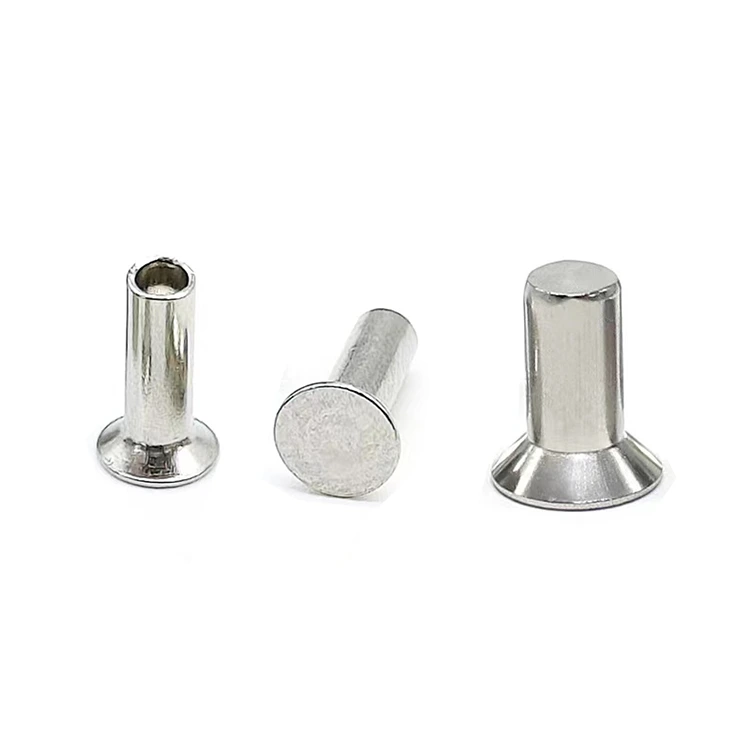Đinh tán hình ống
You can purchase Semi Tubular Rivets from Notin with confidence, as we are a proficient producer of high-quality Semi Tubular Rivets. We promise to provide you with the best after-sale service and prompt delivery.
Semi-tubular rivets are a common mechanical fastener widely used in industrial manufacturing, electronic equipment, automotive parts, and other fields. Their structure lies somewhere between solid and hollow rivets, with a solid head and a hollow tail, combining the advantages of both. The following analyzes the characteristics of semi-tubular rivets and their differences from other rivets from various perspectives.
What are semi-tubular rivets?
Semi-tubular rivets typically have a solid cylindrical or round head and a hollow tubular tail. During installation, pressure is applied to the tail using a riveting tool, causing it to curl outward and form a secure locking structure. This process requires no pre-tapping or welding, making it suitable for quick assembly. In contrast, solid rivets require greater pressure to deform, while fully hollow rivets (such as blind rivets) rely on the mandrel to break to secure, requiring higher material strength.
What head shapes are available for semi-tubular rivets?
Semi-tubular rivet head shapes generally include flat heads (flat heads, suitable for applications requiring smooth surfaces), domed heads (semi-circular heads, aesthetically pleasing and practical, commonly used in construction, automotive, and other fields), countersunk heads (heads embedded within the material, suitable for applications requiring concealed connections), and large flat heads. Different head shapes can be selected based on your needs.

Materials and Strength of Semi-tubular Rivets
Common materials for semi-tubular rivets include aluminum, copper, steel, and stainless steel. Aluminum rivets are lightweight and corrosion-resistant, making them suitable for electronic devices; steel rivets are stronger and are often used in load-bearing structures. Compared to solid rivets, semi-tubular rivets are lighter but have slightly lower shear strength. Compared to full tubular rivets, their curled tails provide a larger contact area, resulting in a more stable connection.
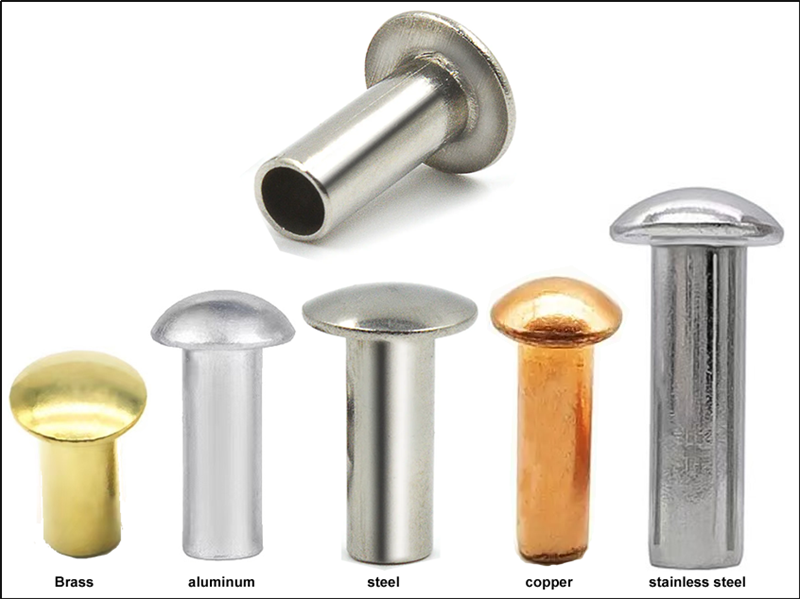
What are semi tubular rivets primarily used for?
Typical uses for semi-tubular rivets include:
-Automotive manufacturing: securing interior panels or wiring harness brackets to prevent loosening under vibration.
-Home appliance assembly: connecting metal casings to prevent deformation caused by welding. -Hardware Tools: Assemble movable parts such as pliers and scissors, ensuring a balance between flexibility and durability.

Semi Tubular Rivet Installation Cost
Semi-tubular rivets can be installed with a standard rivet gun or punch, and can be operated by a single person. They are faster than welding or bolting. For example, the cost per aluminum rivet is approximately 0.05-0.3 RMB, which is lower than stainless steel bolts but higher than ordinary blind rivets. Their advantage is that they require no maintenance over long-term use, eliminating the need for anti-loosening washers or regular tightening.
Limitations of Semi Tubular Rivets
The main disadvantages of semi-tubular rivets are:
-Difficulty in Disassembly: Once a joint is established, it requires multiple drilling and destruction methods to remove it.
-Thickness Limitation: The total thickness of the joined materials is generally no more than twice the length of the hollow portion of the rivet.
-Surface Treatment Requirements: For outdoor use, choose galvanized or stainless steel to prevent rust.
Comparison with Other Fasteners
-Bolts and Nuts: They are removable and have a higher load-bearing capacity, but require access from both sides and are more expensive. - Welding: Excellent connection strength, but thermal deformation may affect precision, and it's not suitable for materials like aluminum and copper.
- Adhesives: No mechanical stress, but poor high-temperature resistance and aging resistance.
In summary, semi-tubular rivets strike a balance between lightweight, easy installation, and cost, making them particularly suitable for specialized connections with medium loads. When selecting a rivet, consider material compatibility, environmental conditions, and load-bearing requirements to ensure a suitable match.
- View as
Đinh tán bán rỗng bằng đồng thau
Tại Nuote Metals, chúng tôi tập trung vào việc chế tạo đinh tán bán rỗng bằng đồng thau. Đinh tán của chúng tôi chủ yếu sử dụng đồng thau H65—hỗn hợp đồng-kẽm mang lại tính dẫn điện và nhiệt cao, cùng với khả năng chống ăn mòn rắn. Vật liệu này vừa đủ cứng vừa đủ linh hoạt để hoạt động tốt với quá trình gia công nguội và tán đinh. Ngoài ra, đồng thau có màu vàng tự nhiên nên nếu sử dụng chúng cho mục đích trang trí, bạn thường không cần mạ thêm.
Đọc thêmGửi yêu cầuĐinh tán nửa đầu Pan
Bạn có bao giờ thắc mắc những chiếc đinh tán rỗng nửa đầu chảo của chúng tôi được tạo ra như thế nào không? Dưới đây là hướng dẫn nhanh:
Đầu tiên, chúng tôi chọn dây kim loại phù hợp và cắt nó theo chiều dài chính xác cần thiết. Sau đó, đến máy dập nguội, máy đục lỗ và tạo hình dây đó thành hình dạng đinh tán cơ bản - đó là nơi mà đầu chảo và thân rỗng thực sự hình thành. Tiếp theo là xử lý nhiệt; chúng tôi điều chỉnh thời gian và nhiệt độ dựa trên vật liệu để đảm bảo mọi đinh tán đều có độ bền và độ dẻo dai phù hợp. Sau đó, chúng tôi thường phủ thêm lớp hoàn thiện bảo vệ – chẳng hạn như mạ kẽm hoặc thụ động – để giúp chúng chống lại rỉ sét và bền lâu hơn. Và chúng tôi không bao giờ bỏ qua bước kiểm tra cuối cùng: mỗi lô đều được xem xét để xác nhận kích thước, độ hoàn thiện và hiệu suất đều đạt tiêu chuẩn.
Chúng tôi luôn sẵn lòng dẫn khách hàng đi tham quan xung quanh – nếu bạn đã từng đến khu vực này, chỉ cần cho chúng tôi biết và chúng tôi sẽ sắp xếp một chuyến tham quan!
Đầu nấm nửa đinh tán rỗng
Đinh tán rỗng nửa đầu nấm lấy tên từ đầu hình vòm đặc trưng của chúng, trông hơi giống mũ nấm, kết hợp với phần thân rỗng một phần. Thiết kế này cho phép đinh tán tự định hình trong quá trình lắp đặt, tạo độ bám chắc chắn—hoàn hảo cho những mục đích sử dụng mà bạn cần cả vẻ ngoài đẹp mắt lẫn hiệu suất chắc chắn. Khi được đặt, đầu rỗng sẽ bung ra và bám chắc chắn, trong khi phần đầu và phần trên của chuôi vẫn vững chắc để hỗ trợ thêm.
Đọc thêmGửi yêu cầuĐinh tán nửa ống sắt
Đinh tán nửa ống sắt là đầu nối cơ khí có đuôi rỗng. Chúng hoạt động bằng cách ép phần rỗng và đẩy nó ra ngoài để tạo ra sự cố định vĩnh viễn. Các ứng dụng cốt lõi tập trung vào các ngành công nghiệp nhẹ như may mặc, giày dép và hành lý. Việc sử dụng vật liệu dây mềm giúp tránh bị nứt trong các mối nối đinh tán và mang lại lợi thế về chi phí. Nuote Metals là nhà sản xuất đinh tán nửa ống sắt chuyên nghiệp. Đinh tán của chúng tôi có chất lượng cao và mỗi đinh tán đều được kiểm tra kỹ lưỡng để đảm bảo sự hài lòng của khách hàng.
Đọc thêmGửi yêu cầuĐinh tán bán chìm đầu chìm
Tại sao nên chọn đinh tán bán rỗng đầu chìm thay vì các phương pháp kết nối khác? Điều này chủ yếu là do những lợi thế độc đáo của họ. Sau khi lắp đặt, đầu bằng phẳng với bề mặt, tránh các nguy cơ gây nhiễu hoặc an toàn tiềm ẩn do các phần nhô ra gây ra. Thiết kế nửa rỗng giúp quá trình tán đinh tương đối đơn giản, không cần thiết bị phức tạp; nó thường có thể được hoàn thành bằng tay hoặc bằng các công cụ khí nén. Loại đinh tán này phù hợp với các vật liệu có độ dày khác nhau và có thể thích ứng với nhiều tình huống khác nhau bằng cách điều chỉnh lực tán đinh.
Đọc thêmGửi yêu cầuĐinh tán nửa đầu phẳng
Tán đinh là một phương pháp phổ biến để gắn chặt hai hoặc nhiều bộ phận lại với nhau trong sản xuất công nghiệp và bảo trì hàng ngày. Đinh tán rỗng nửa đầu phẳng là một loại đinh tán, mang lại lợi thế về thiết kế và ứng dụng độc đáo. Nuote Metals là nhà sản xuất chuyên nghiệp về đinh tán rỗng nửa đầu phẳng. Chúng tôi đặt trụ sở tại Đông Quan, Trung Quốc và có nguồn tài nguyên xử lý bề mặt dồi dào và giao thông thuận tiện, giúp giảm chi phí sản xuất đinh tán.
Đọc thêmGửi yêu cầu

